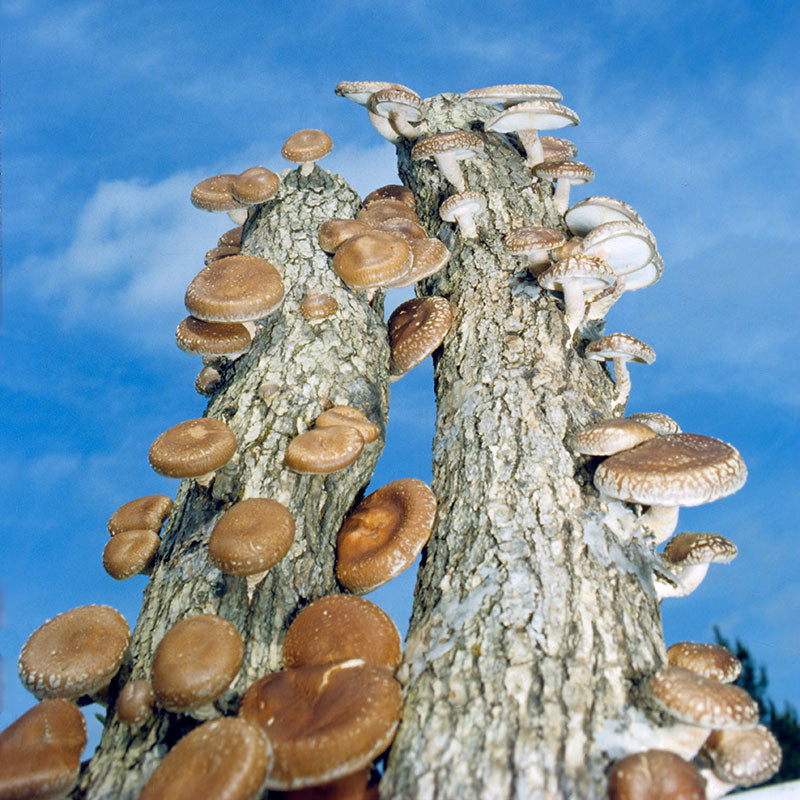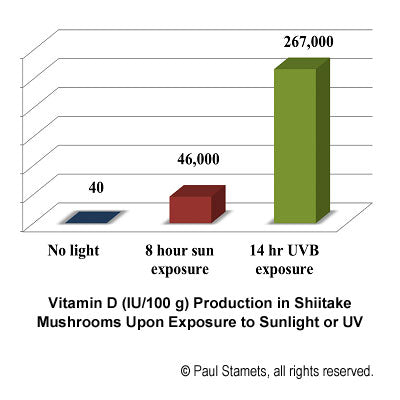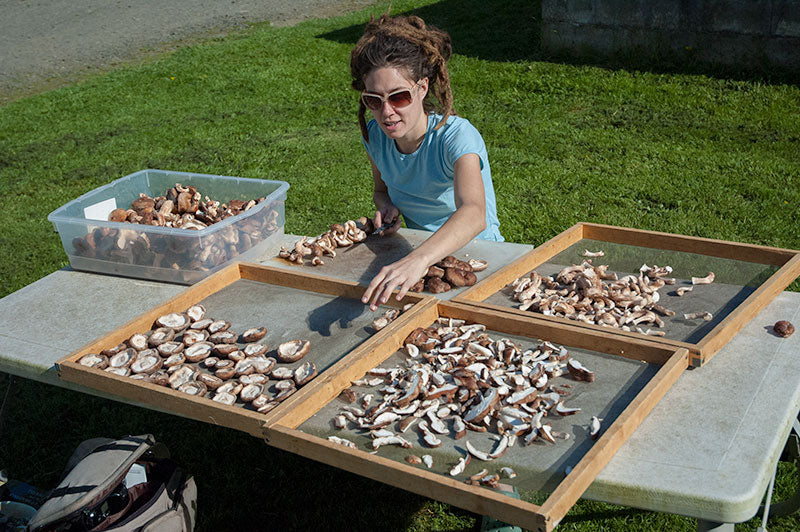
Place Mushrooms in Sunlight to Get Your Vitamin D
(Originally published online in Huffington Post's Healthy Living section.)
Vitamin D is an essential vitamin that boosts the immune system and plays vital roles in human metabolism. Did you know that tasty mushrooms are one source for vitamin D, and that you can naturally multiply their levels by exposing them to sunlight?
We evolved living in more sunlight than today. We make our own vitamin D when sunlight hits our skin cells. Many people living in the northern hemisphere, however, suffer from lower levels of vitamin D during the fall, winter and spring. Fortunately, you can make your own supply of vitamin D-enriched mushrooms by simply exposing them to sunlight. You can sun dry or UV-zap store-bought or homegrown shiitake, maitake, button, and many other mushroom species. My personal preference is home grown organic shiitake. The high vitamin D levels generated will last for more than a year. Surprisingly, even sliced and dried mushrooms—including wild ones picked the year before—will soar in vitamin D when placed outdoors under the sun. Now, the summer time, from June until September, is the best seasonal window for people in northern latitudes to make vitamin D enriched mushrooms!
Many physicians view low levels of vitamin D as a serious medical pre-condition. In extreme cases, vitamin D deficiencies can cause diseases such as rickets. Insidious diseases, such as cancer, are immune-mitigated. Without adequate vitamin D levels, your immune system is impaired. This is why cancer patients are often prescribed high daily doses of vitamin D, up to 4,000–10,000 International Units (IU), compared to the FDA recommended Daily Value (DV) dose of 400 IU for adults over 50 years in age. Please consult your physician before taking such large doses (40 IU is equal to 1 microgram).

Shiitake mushrooms growing from oak logs
New recommendations from the Institute of Medicine, a branch of the National Academy of Sciences, increase the dosage to 600 IU per day for people up to age 70, and 800 IU for those over 70. Many naturopaths and physicians suggest ingesting at least 1,000 IU/day. A 2012 report in the Journal of Clinical Endocrinology & Metabolism combined the results of eight clinical studies and showed that older people taking 1,000 IU of vitamin D, in combination with 1,000 mg of calcium, for three years had a 7% reduced death rate (Rejnmark, 2012). When not ingesting vitamin D mushrooms, and especially when traveling, I take a 1,000 IU wild Sockeye Salmon vitamin D3/Omega 3 product several times a week, or daily when I remember.
The commercially common sources of vitamin D are vitamin D3 (cholecalciferol) that comes from sheep’s wool (lanolin), pigskins, and some oily fish (mackerel, sardines, anchovies, herring, trout, and salmon). Mushrooms and animal skins create vitamin D when exposed to sunlight. Mushrooms are rich in the vitamin D precursor ergosterol, which ultraviolet B (between wavelengths of 290 nm to 315 nm) converts to ergocalciferols, also called provitamin D2. Mammfal epidermis has cholecalciferol, which ultraviolet light converts to D3.
Which is better, Vitamin D3 or D2? The New England Journal of Medicine published an exhaustive article comparing the metabolic pathways of vitamin D2 and vitamin D3 (Holick, 2007). Our enzymes convert both D vitamins into 25-hydroxyvitamin D, and then into the active form of 1,25-dihydroxyvitamin D in our kidneys. This form of vitamin D can bind to receptors in various tissues around the body for use. One advantage of vitamin D3 is its longevity after ingestion—staying in the bloodstream for weeks compared to days for vitamin D2. However, for people taking vitamin D supplements several times a week, there seems to be no significant advantage in taking one form or the other.

Shiitake mushrooms flushing from a home grown kit
Moreover, eating mushrooms packed with vitamin D2 confers many other health benefits. Mushrooms have many helpful nutrients, including beta glucans for immune enhancement, ergothioneines for antioxidative potentiation, nerve growth stimulators for helping brain function, and antimicrobial compounds for limiting viruses. I will write more about these in future issues of the Huffington Post.
While making your own vitamin D3 from sheep or pigskins may be possible, it is rather gruesome and technically difficult. Consuming vitamin D3 from fish is not an option for vegetarians. Vitamin D from mushrooms is not only vegan and vegetarian friendly, but you can prepare your own by exposing mushrooms to the summer sun. Mushrooms grown indoors have very little vitamin D but reserve great potential for hyper-producing it.
Here is a simple experiment we did one summer afternoon in Kamilche Point, Washington. We compared several forms of organically grown shiitake mushrooms, which had starting level of 100 IU/100 grams. We compared the vitamin D levels of three sets of mushrooms, all from the same crop. The first was grown and dried indoors. The second set was dried outdoors in the sunlight with their gills facing down. The third set of mushrooms was dried outdoors in the sunlight with their gills facing upwards for full sun exposure. The most vitamin D was found in shiitake dried with gills up that were exposed to sunlight for two days, six hours per day. The vitamin D levels in these mushrooms soared from 100 IU/100 grams to nearly 46,000 IU/100 grams (see chart). Their stems, though, produced very little vitamin D, only about 900 IU. Notably, vitamin D levels dropped on the third day, probably due to over-exposure to UV.
Most interesting to me is that when we tested our mushrooms nearly a year after exposure, they preserved significant amounts of vitamin D2. I suspect values are much higher initially, gradually falling in time, consistent with reports by other researchers. This means that you can capture vitamin D in mushrooms and have a ready source of this important vitamin—and delicious mushrooms—through the fall, winter, and spring.

How much vitamin D can 100 grams of fresh mushrooms make from sunlight? A lot, but a lot more when mushrooms are dried, pulverized, and then exposed to UVB light lamps. Caution: Using UVB light lamps can cause damage to your eyes and skin. Do not attempt this without taking necessary precautions.
Robert Beelman at Penn State University was one of the pioneers who learned that pulsing high intensity beams of UV could generate vitamin D (and also, bonus, surface-sterilize the mushrooms). Thanks in large part to his work, UV-exposed mushrooms—primarily the fresh button variety—are increasingly available in grocery stores. When we ranked the vitamin D concentrations of shiitake exposed to no light, exposed to sunlight with gills up, and exposed to continuous UVB light after slicing, the results were impressive: more than a six-fold increase under UVB light compared with sunlight.
These results make sense. When mushrooms were sliced, more ergosterol-rich surface area was exposed. The indoor UV light was more intense than sunlight. The combination of these resulted in more vitamin D being produced. Although up to 12 hours of sun exposure to upside-down (gills up) shiitakes created 46,000 IU of vitamin D, I am sure sliced ones would give you more, as the surface area would increase. However, the sun is a convenient source of UVB whereas setting up a UVB light chamber is not.
Here is how to do it:

Shiitake mushrooms ready for natural vitamin D enhancement
1) Obtain fresh Organic shiitake, maitake, button, oyster, shimeji or other mushrooms.
2) On a sunny day in June, July or August, slice the fresh mushrooms. Place them evenly on a tray exposed directly to the sun from 10 am to 4 pm.
3) Before nightfall, cover the mushrooms with a layer of cardboard to block moisture from dewfall.
4) The next clear day repeat exposure to the sun from 10 am to 4 pm.
5) Remove the mushrooms and finish drying (if necessary in a food dehydrator until they are crispy).
6) When thoroughly dry, store in a glass jar or sealed container. Adding a tablespoon of uncooked rice as a moisture absorber will help keep the mushrooms dry. The mushrooms should be good for a year or more, depending upon conditions.
7) Take 10 grams daily per person, about a small handful. Rehydrate in water for one hour. The mushrooms will swell. Then cook as desired.
A natural question to ask is how much of the vitamin D from consuming mushrooms makes it into my bloodstream? Comparing 26 people who took a vitamin D2 supplement to 26 others ingesting vitamin D-enriched mushrooms four times per week for five weeks, researchers at the University Medical Center in Frieburg, Germany found that the serum levels of vitamin D were similar. They used button mushrooms exposed to UV light that resulted in 20,000 IU/100 grams fresh weight. Subjects ingested 120 grams fresh (≈24,000 IU) of vitamin D-enriched mushrooms, which is about a quarter of a lb., roughly a handful. The results showed similar levels of vitamin D were absorbed in the blood in both groups: those who ingested a supplement in pill form and those who put freshly cooked mushrooms in soup. At the end of the study, both groups’ serum vitamin D levels increased to ~50 nmol/L, which is considered to be a healthy baseline level. A general consensus amongst many health care practitioners is that you need to replenish your vitamin D so blood serum levels are between 50 and 125 nmol/L of 25-hydroxyvitamin D. Care should be taken to avoid over-supplementation, as serum levels over 125 nmol/L can be hazardous (see chart).
Institute of Medicine Recommendations for Serum Concentrations of Vitamin D
|
Serum 25-Hydroxyvitamin D [25(OH)D] Concentrations and Health* |
||
|
nmol/L** |
ng/mL* |
Health status |
|
<30 |
<12 |
Associated with vitamin D deficiency, leading to rickets in infants and children and osteomalacia in adults |
|
30–50 |
12–20 |
Generally considered inadequate for bone and overall health in healthy individuals |
|
≥50 |
≥20 |
Generally considered adequate for bone and overall health in healthy individuals |
|
>125 |
>50 |
Emerging evidence links potential adverse effects to such high levels, particularly >150 nmol/L (>60 ng/mL) |
* Serum concentrations of 25(OH)D are reported in both nanomoles per liter (nmol/L) and nanograms per milliliter (ng/mL).
** 1 nmol/L = 0.4 ng/mL
Institute of Medicine, Food and Nutrition Board. Dietary Reference Intakes for Calcium and Vitamin D. Washington, DC: National Academy Press, 2010.
—The Office of Dietary Supplements does not promote or endorse any product or service described in this article.
Mushrooms are not only wonderful sources of vitamin D, but they offer us many opportunities for maintaining and improving health. Whether you expose cultivated mushrooms, or wildly harvested edibles, both become jam-packed with vitamin D after light exposure. Mushrooms are truly super foods!
Recommended website:
NIH Office of Dietary Supplements Fact Sheet on Vitamin D
References Used for this Article:
Beelman, R. & M. Kalaras. "Post-harvest Vitamin D Enrichment of Fresh Mushrooms." HAL Project# MU07018 (April 30, 2009), Penn State University.
U.S. Mushroom Council & Australian Mushroom Growers Association.
Holick, M.F. "Vitamin D Deficiency." New England Journal of Medicine, 2007; 357(3):266-81.
Institute of Medicine. "Dietary Reference Intakes for Calcium and Vitamin D." 2010. Washington, DC.
Lappe J.M., Travers-Gustafson D., Davies K.M., Recker R.R., Heaney R.P. "Vitamin D and calcium supplementation reduces cancer risk: results of a randomized trial." American Journal of Clinical Nutrition. 2007; 85(6):1586-1591.
Rejnmark, L. "Vitamin D with Calcium Reduces Mortality: Patient Level Pooled Analysis of 70,528 Patients from Eight Major Vitamin D Trials."
Journal of Clinical Endocrinology and Metabolism. Published online May 17, 2012, doi: 10.1210/jc.2011-3328.
Stamets, P. & G. Plotnikoff. "Anticancer Medicinal Mushrooms Can Provide Significant Vitamin D 2 (Ergocalciferol)." International Journal of Medicinal Mushrooms. 2005; 7(3):471-472.
Stamets, P. "Notes on Nutritional Properties of Culinary–Medicinal Mushrooms" International Journal of Medicinal Mushrooms. 2005; 7(1&2):103-110.
Stamets, P. Mycelium Running: How Mushrooms Can Help Save the World. 2005. Ten Speed Press, Berkeley.
Urbain, P., et al. "Bioavailability of vitamin D2 from UV-B-irradiated
button mushrooms in healthy adults deficient in serum 25-hydroxyvitamin D: a randomized controlled trial." European Journal of Clinical Nutrition. 2011; 65:965-971.
